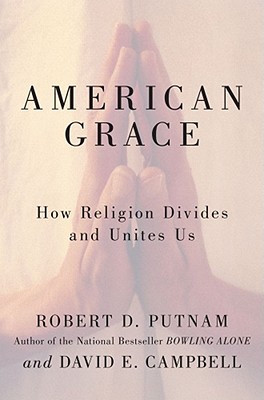American Grace: How Religion Divides and Unites Us
Robert D. Putnam

Having been a big fan of Putnam’s “Bowling Alone”, I have to say that I was not that impressed with “American Grace”. For one thing, it is incredibly long (550 pages), and its conclusions are mildly interesting at best (to me). BA addressed issues that I hadn’t thought about too much, whereas AG addresses things that are all over the media all the time. It’s true that the authors turn up some findings that contradict the conventional wisdom, but they don’t make for the incredibly forceful type of argument marshalled in BA.
I actually would have given this book two stars but for two sections. First, all of the “vignettes” where they leave the statistics and profile a few congregations are pretty interesting. Second, I was very interested by the findings in Chapter 13, “Religion and Good Neighborliness”. (I would have appreciated reading it as a scholarly article rather than one chapter in a 550-page book, though.) Unsurprisingly it is the chapter most closely related to the subject matter of BA. The authors first find a high correlation between religiosity and various measures of community involvement, giving, and general niceness. I think that result in itself was reasonably well established before this book. What I found particularly interesting, though, is that the authors dove into the statistics to tease out what specific aspects of religiosity drive these things. And their finding, which they present fairly unambiguously, is that statistically speaking, the driver of all those nice things is specifically social connections with people in your religious congregation. This is in contrast to either social ties with “just anyone” (which make a difference, but not nearly as much), as well as strength of religious convictions (for example, that you should follow the Ten Commandments) and frequency of individual religious practice (such as reading the Bible or praying). Interestingly, religious convictions and individual practice have no effect on civic engagement once you control for congregation-based social ties.
I think this is a fascinating result, and one that resonates with positions of Stanley Hauerwas that I have come to identify with. Specifically, Hauerwas contends that the only legitimate way of practicing Christianity is by practicing and living it out in a community informed by the story of Israel and Jesus (and I don’t think it’s too great a leap to extend this general principle to other religions). It is important that the Kingdom of God is a community and you can’t really live it out on your own.
The authors note that it’s possible that this finding doesn’t necessarily only apply to religion per se, and that it is possible that a similar effect could obtain from other communities where social bonds have a serious moral foundation; but they also note that there are few if any good examples of such other communities in practice.
Both of the above observations are reasons why I recently have started going to church again, so it did make me happy to read that the data are on my side!